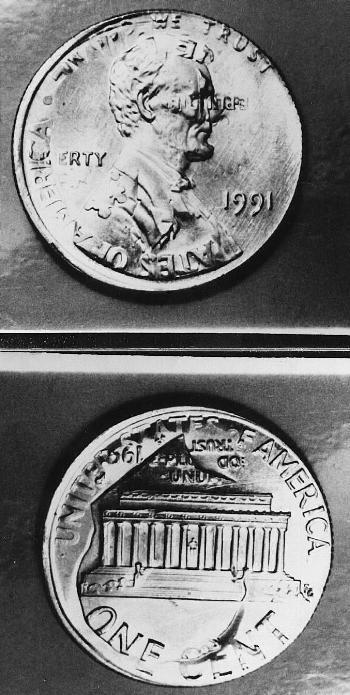
Ken Potter's Educational Series ...


Ken Potter's Educational Series ...

11-cent piece explained
by Ken Potter - NLG
December 27, 1998
© Ken Potter 1998
 One of the most dramatic and highly collectable of the striking
errors is the "double denomination", or in the case of the Lincoln cent, what is
affectionately referred to by collectors as an "11-cent piece." The error type
is so eye appealing and mesmerizing that even non-error collectors frequently do a
"double-take" and an example or two in a dealer's
One of the most dramatic and highly collectable of the striking
errors is the "double denomination", or in the case of the Lincoln cent, what is
affectionately referred to by collectors as an "11-cent piece." The error type
is so eye appealing and mesmerizing that even non-error collectors frequently do a
"double-take" and an example or two in a dealer's
showcase is likely to draw crowds of non-collectors as individuals drag friends and
relatives over for a finger-pointing session of the ‘freak-show’ followed by the
inevitable inquiries as to how they got out of the Mint. The "11-cent piece" is
also one of the few error coins that has so much collector appeal that it could almost be
termed a "cross-over coin" as it’s one of the few errors that many
non-error coin dealer will stock and many non-error coin collectors will buy.
As the name implies, the error involves the striking of a planchet by the dies of two different denominations. The 1991 Lincoln cent (illustrated in the photo supplied by Alan Herbert), was first struck normally by ten-cent dies and was then transported to another press and stuck a second time by one-cent dies. This one is known as a "flip-over" because the ten-cent design was stuck by the one-cent dies, reverse to obverse. It would also be described as showing two dates as both the Lincoln cent and Roosevelt dime dates are visible. Although the final digit of the understrike is flattened out and a bit harder to see the fact it can be seen qualifies it as showing two full dates. The desirability of an 11-cent piece is often gauged by the amount of detail that is present from both strikes. If the understrike is difficult to view due to a stronger strike than average by the cent dies then it is considered less desirable than a strike that shows an almost equally matched composite design from both denominations. While I’ve seen better examples, the one shown is a better than average strike with lots of collector appeal. This particular piece sold for about $400 several years ago.
This error type occurs most frequently when a tote bin fails to be emptied all the way and a struck dime (or more) from a previous operation remains stuck in a corner or in the groove of a tote bin door. It the bin is then used to transport planchets for one cent coins to a press for striking, the struck dimes may get mixed in and struck a second time as a Lincoln cent.
Ken Potter is the official attributor and lister of world doubled dies for the Combined Organizations of Numismatic Error Collectors of America and for the National Collectors Association of Die Doubling. He privately lists U.S. doubled dies and other collectable variety types on both U.S. and world coins in the Variety Coin Register.
For more information on either of the clubs, or on how to get a variety listed in the Variety Coin Register he may be contacted at: Kpotter256@aol.com. An Educational Image Gallery may be accessed on his website at: http://www.uscents.com/potter/
Ken Potter
P.O. Box 760232
Lathrup Village, MI 48076-0232
Phone: 1-(313)255-8907 E-mail: KPotter256@aol.com
Numismatist Since 1959 ~ Serving the Collector Since 1973
CONECA's Longest Serving Doubled Die Attributer
Member of: ANA
CONECA-LM NLG NCADD-FM MSNS-LM
NWDCC RCC COINMASTERS LCS WBCC BBCC
Visit our website to view 40+ pages of
Error-Variety Coins, U.S. Defaced Coinage Dies, Medals, Silver Art Bars/Rounds, Numismatic
Books & Supplies and an Educational Image Gallery by clicking below:
Ken Potter's Variety Vault

Or Go Directly To Each Updated Page by clicking below:
Books &
Supplies
Error-Variety Coins
Rare-Coin-Reproductions
Defaced U.S. Coinage Dies
Book-Of-The-Month Special
Bars-Medals-Rounds & Other
Exonumia
Error/Variety Coin Examination Services
For a List of Our eBay Auctions please click below:
Our eBay Auctions
Unless otherwise stated, all Photographic Images are
by Ken Potter. Copyright Ken Potter, 1993, 1994, 1995, 1996, 1997, 1998, 1999,
2000, 2001. Use of images in any manner is strictly prohibited without the express
written permission of the copyright holder.
Free counters provided by Honesty.com.